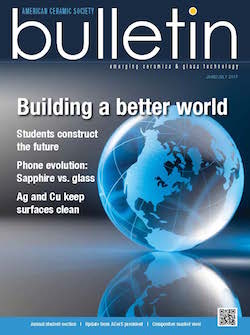
The June/July 2017 issue of the ACerS Bulletin is now available online. This special double issue is all about building a better world, from highlighting the activities of the next generation to the future of smartphones and antimicrobial surfaces.
ACerS president Bill Lee provides an introduction to the issue with his second installment in a series of updates to members about key themes that he is focusing on during his presidency. Flip to page 3 to find out more about the Society’s initiatives that are focused on the next generation—ACerS young members.
Speaking of which, ACerS young members also have their own voice in this issue’s annual student section. PCSA chair Tess Davey provides an introduction to the section, and ACerS student liaison Tricia Freshour recaps the students’ recent Congressional Visits Day 2017. Held April 4–5, Congressional Visits Day provides students with the opportunity to travel to Washington to educate decision makers about the importance of funding for basic science, engineering, and technology. Plus, the student section features articles detailing students’ activities, research, and ideas, written by students Ryan Anderson, Haley Barnes, Jindaporn Juthapakdeeprasert, and Wirat Lerdprom. Turn to page 34 to get started.
Plus, there’s a lot more inside the June/July issue of the ACerS Bulletin.
When it comes to cover screens for personal electronic devices, which is better—strengthened glass or sapphire? Authors Arun Varshneya and Peter Bihuniak discuss the material manufacturing and article fabrication processes and costs for the two materials as cover screens. How have consumer preferences driven material choices? And what is driving the future of new materials for cover screens? The article explores the advantages and disadvantages of each material’s physical properties, including strength, abrasion resistance, fracture toughness, light reflection, and more. In light of Apple’s recent $200 million investment with Corning, the material choice for smartphone cover screens is as timely as ever—delve into the discussion on page 20.
In addition, the new issue of the ACerS Bulletin also features an article detailing a case study of attempts to devise more simple methods for antimicrobial surfaces. Authors Taki Negas, Dave Hilfiker, and Scott Bartkowski detail their efforts to ion-exchange silver and copper ions into the surface of glass and glass-bonded ceramics. Flip to page 26 to see how their techniques and materials fared against E. coli, algae, and fungi growth—and what the results might mean for future antimicrobial products.
Plus, the Business and Market View column this month, a special preview of a BCC Research market report, focuses on ceramic matrix and carbon matrix composites—a class of materials that is projected to grow at a CAGR of 9.4% through 2021. Turn to page 48 to read more stats about this growing market.
There’s lots more good stuff inside this—and every issue—of the ACerS Bulletin. The current issue is free to all for a short time, but remember that all the valuable content in over ninety years of past issues of the ACerS Bulletin is free only to members—so considering joining us today!

